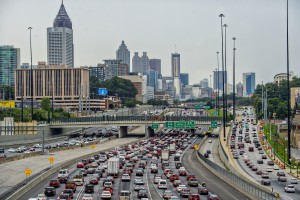Interstates vs Arterial Roads
In 2011, in the early hours of Tuesday, February 8th, something happened that would not only shut down one of the busiest roads in Georgia but also serve to demonstrate one of the fatal flaws in Metro-Atlanta’s road system. Between midnight and 1:00am on Tuesday, a wrong-way driver going west in the eastbound lane of the DeKalb County section of I-285 struck a tanker truck full of margarine which then ignited (“I-285 Wreck …”). It was several hours before crews were able to get to the wreck to douse the flames and even then, the specifics of the situation presented some challenges. The margarine not only acted as an accelerant but also made the roads slick and threatened to pollute the drainage systems around the highway, so the Georgia Department of Transportation (GDOT) had to spread sand to give drivers more traction and employ hazmat teams to contain the spill (“Police Continue …”). This crash kept the eastbound lane of the northside Perimeter completely closed for about 10 hours, long enough to affect the morning-commute surge of traffic the next day.
This type of occasion is where Metro-Atlanta’s road network really drops the ball and caves in on itself. For most major cities, Interstate Highways are mostly intended for through-traffic; truckers and long distance drivers rather than locals just trying to get to work. Meanwhile, Arterial Streets are intended for commuters and are also meant to relieve pressure from significant delays on the highways. This is obviously not the case in Atlanta, where any trip into the city from outside the Perimeter is going to funnel you into I-85, I-75, I-20 or the Downtown Connector depending on where you’re coming from and where you’re going. This is due mostly to the expansion of the city through sprawl. Unlike Chicago or New York City, Atlanta is land locked with no natural barriers like mountains or bodies of water to prevent expansion in all directions or encourage dense urban development (“Atlanta is no New York …”). As Metro-Atlanta expanded geographically, the winding, shoulder-less and outdated arterial roads like Ga. 20, Cobb Parkway and Ashford Dunwoody Road were no longer able to serve commuters’ needs and they began to rely much more heavily on the Interstate system to get to and from their daily destinations. In response, GDOT beefed up these highways to the massive 12-lane corridors they are now, while allowing arterial roads to become antiquated and obsolete to the needs of modern residents of the Metro Area. While it is inefficient, under normal circumstances this system of funneling most traffic onto the highways works predictably enough that motorists can reach their destinations on time. But this unstable formula provides the powder-keg backdrop for accidents and delays like the margarine explosion to get blown way out of proportion. With the surrounding arterial roads unable to effectively complement the interstate system, there is no high capacity alternative for I-285. Miles away from the site of the crash and fire, roads like Johnson Ferry and Ashford Dunwoody were flooded with overflow traffic. One commuter who normally takes I-285 West from Calhoun to Norcross reported that she was forced to take a 90-mile triangular route, taking I-75 into Downtown Atlanta and then going north on I-85 to get to work. This detour took her 3 hours and was still a better option that taking the arterial roads that connect Calhoun to Norcross (“I-285 Wreck …”). While this wreck is spectacular in it’s severity, it shows just how bad congestion can get in Atlanta when provided with a sufficient catalyst. This epidemic of outdated Arterials combines with Atlanta’s far-flung sprawling suburbs creates a tendency for traffic jams that is literally built-in to the city’s framework.

